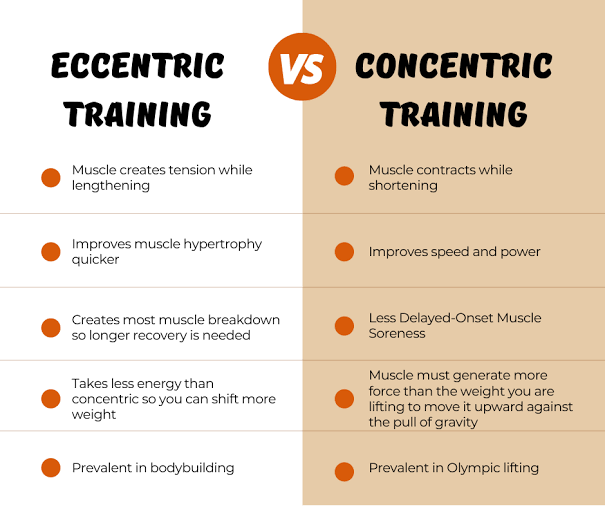If you’ve ever hit the gym or tried out a new workout routine, you’ve probably heard the terms eccentric and concentric being tossed around. But what do they really mean? And why should you care about them when it comes to your fitness goals? In this blog post, we’re diving deep into the world of eccentric vs concentric muscle movements—explaining what they are, how they affect your workout, and why knowing the difference can help you train smarter and more effectively.
Table of Contents
- Introduction
- What Is Eccentric Muscle Contraction?
- What Is Concentric Muscle Contraction?
- Eccentric vs Concentric: The Key Differences
- Why Do Both Matter in Your Workout?
- How to Use Eccentric and Concentric Movements for Better Results
- Conclusion
- FAQs
What Is Eccentric Muscle Contraction?
Let’s start with eccentric contractions. These happen when a muscle lengthens while it’s under tension. Sounds a bit strange, right? But here’s an example: when you lower a dumbbell in a bicep curl, your bicep muscle is slowly lengthening while still holding the weight in control. This is an eccentric movement. Essentially, you’re controlling the weight as it moves down.
Eccentric exercises are great for building muscle strength and size, especially because they create more muscle damage (in a good way) that leads to muscle growth. So, the next time you’re lowering a weight in your workout, know that your muscles are doing important work.
What Is Concentric Muscle Contraction?
Now, let’s talk about concentric contractions. These are the opposite of eccentric contractions. In a concentric movement, your muscle shortens while generating force. For example, during a bicep curl, the action of lifting the dumbbell up involves your bicep shortening as it contracts to move the weight upward.
Concentric movements are typically what most people think of when they imagine a strength exercise. They’re often the focus of many workouts since they’re the part of the exercise that seems to “build” the muscle.
Eccentric vs Concentric: The Key Differences
To put it simply, here’s the main difference:
- Eccentric: Muscle lengthens while under tension (lowering a weight).
- Concentric: Muscle shortens while generating force (lifting a weight).
Example Exercise:
Let’s take a squat, which uses both eccentric and concentric movements:
- Eccentric: Lowering your body down into a squat position.
- Concentric: Pushing through your legs to stand back up.
Both phases work your muscles in different ways, and both are necessary for a balanced workout routine.
Why Do Both Matter in Your Workout?
You might be wondering, “Why do I need both?” Well, each type of muscle contraction plays a unique role in your training:
- Eccentric Movements: These are more effective for muscle growth (hypertrophy) because they create more micro-tears in muscle fibers. This results in more muscle repair and growth after the workout.
- Concentric Movements: These build power and strength, helping you lift more and move heavier loads. Concentric contractions focus on overcoming the resistance (the weight) to perform the movement.
Incorporating both types into your workout ensures that you’re getting the most out of your exercises. If you only focus on concentric movements, you might miss out on the muscle-building potential that eccentric movements provide. And vice versa!
How to Use Eccentric and Concentric Movements for Better Results
To get the best of both worlds, you should aim to include both eccentric and concentric movements in your workout routine. Here are some tips for making the most of each:
- Focus on Slow Eccentric Movements: Try slowing down the lowering phase of exercises like squats, push-ups, or bench presses. This increases the time your muscles are under tension, which leads to more muscle growth.
- Use Controlled Concentric Movements: During the lifting phase, make sure you’re controlling the weight as it moves up. This helps build strength and ensures proper form.
- Try Eccentric-Only Workouts: Some people even focus on eccentric training, using the lowering portion of an exercise to create more muscle damage and stimulate growth.
Conclusion
Understanding the difference between eccentric and concentric muscle contractions is essential for anyone looking to take their fitness routine to the next level. While concentric movements help you build strength, eccentric movements play a crucial role in muscle growth and endurance. To maximize your results, make sure you’re incorporating both types of movements into your workout plan!
People Also Ask
1. Which is better: eccentric or concentric training?
Neither is better than the other; both types of contractions are important. Concentric movements help build strength and power, while eccentric movements are key for muscle growth and recovery.
2. Can I do only eccentric exercises?
Yes, eccentric exercises can be effective on their own, especially for muscle growth. However, it’s important to balance them with concentric movements to ensure overall strength and muscle development.
3. How slow should I go during eccentric movements?
Slowing down the eccentric phase of an exercise can be beneficial for muscle growth. Aim to take 2-4 seconds for the lowering portion of each rep.
4. Are eccentric movements safer than concentric movements?
Eccentric movements can sometimes be more taxing on the muscles and joints, but with proper form and control, they’re safe and effective. Always ensure you’re using the right weight and technique.
By incorporating both eccentric and concentric movements into your workouts, you can make sure your muscles get the attention they need for both strength and size. So, next time you hit the gym, try to be mindful of both phases of your exercises and watch your progress soar!



